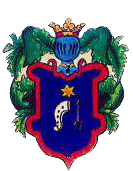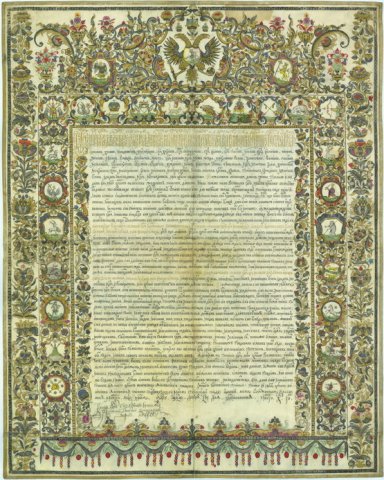| |
 |
|
|
| |
|

© 2007 Family club Gurchin
|
|
|
|
|
|
In the vast Polish dictionary is only one appropriate word - the verb"krupisie", whose value is "responsible, take responsibility foranything". There is another version of the variant names Emblem - "we are many".
As members of the genus Gurchin historically occurred on the territory of Poland and Lithuania, the request was made in thegenealogical center of Poland on the coat of arms Kruposin. The reply stated that there is no literature available to them informationabout the emblem and the need for special studies.
Was tested on the Czech version of the origin of the emblem. Inresponse, "Archiv Hlavniho Mesta Prahy" said that his fund does not have any information about the emblem Kruposin, nor about the kindGurchin. However, they believe that the emblem is drawn to thePolish-Lithuanian taste.
It was suggested that the Polish archives on the lands of the formerPrussian Selezii and Regional Archives Opava in the Czech Republic, which have large heraldic archives.
Referring to the last response was received in their archives and the available literature no information on the coat of arms and kind.
They suggest the Polish-Lithuanian descent, and was accompanied by a photocopy from the hoofs on the coat of arms of Polish gentry from the book "Polnisches Wappenbuch von Wladislaw v. Nowina-Chrzanowski ". Bonn, 1982, from which it follows that Kruposin may have a different origin.
According to the rules of heraldry, the shape of a shield, whicharranged the heraldic signs are divided into types: Varangian,French, etc. In ancient times, it also was significant, indicating in some way on the nationality of the knight (though not always). We have a German panel, the so-called "tarch", with a recess under the spear to his right hand. Natural tarch looked like the one below.
 In heraldry, its stylized, adding to the symmetry of yet another notch. In this form, looks like our shield. For comparison: in heraldry, Polish chivalry, usually a mixture ofFrench and German type, and in coats of arms of cities dominated by a simple cut-outs under the shield without a weapon. But the ancient emblem of the city of Gdansk has a clear German uniform - a shield with two notches, as in our coat of arms. Since1308-1454's Gdansk was ruled by the German Teutonic Knights,then on the shield are placed two crosses.
So that our shield German. In heraldry, its stylized, adding to the symmetry of yet another notch. In this form, looks like our shield. For comparison: in heraldry, Polish chivalry, usually a mixture ofFrench and German type, and in coats of arms of cities dominated by a simple cut-outs under the shield without a weapon. But the ancient emblem of the city of Gdansk has a clear German uniform - a shield with two notches, as in our coat of arms. Since1308-1454's Gdansk was ruled by the German Teutonic Knights,then on the shield are placed two crosses.
So that our shield German.
According to linguistic rules, we can assume that our family is formed from the base of Hurt (for example - gurchenie - is an operation causing scratches on the edge of the coin), formed byGurt (band), that is ending "t" becomes "h ". In German, Hurtig - fast,agile.
The colors used in our arms, mean:
- gold pieces - a symbol of nobility and wealth,
- lazure shield - generosity,
- scarlet (reddish) framing Shield - bravery.
The presence of a six-pointed star emblem has no relation to the Jewish Star of David, as occurs in many coats of arms, including the coat of arms of Thuringia in the heart of Germany. Also erroneous association surnames Gurchin with the Jewish origins of surnames Hurwitz, etc. The fact that the names of the Jewish population of Europe appeared only in the late 18 th century (since 1797), and even then, they were either invented by Austrian officials, or were descended from the geographical name of habitats. Same Gurevich, Hurwitz, Gurvich - from Horovice in the Czech Republic. |
|
From Wikipedia - Coat of arms Kruposin |
|
Historical Documents (Documents from Archives) |
|
Lukasz Netczuk “Information - Gurchin in Poland”
 |
|
|
|
|
|
|
|





 In heraldry, its stylized, adding to the symmetry of yet another notch. In this form, looks like our shield. For comparison: in heraldry, Polish chivalry, usually a mixture ofFrench and German type, and in coats of arms of cities dominated by a simple cut-outs under the shield without a weapon. But the ancient emblem of the city of Gdansk has a clear German uniform - a shield with two notches, as in our coat of arms. Since1308-1454's Gdansk was ruled by the German Teutonic Knights,then on the shield are placed two crosses.
So that our shield German.
In heraldry, its stylized, adding to the symmetry of yet another notch. In this form, looks like our shield. For comparison: in heraldry, Polish chivalry, usually a mixture ofFrench and German type, and in coats of arms of cities dominated by a simple cut-outs under the shield without a weapon. But the ancient emblem of the city of Gdansk has a clear German uniform - a shield with two notches, as in our coat of arms. Since1308-1454's Gdansk was ruled by the German Teutonic Knights,then on the shield are placed two crosses.
So that our shield German.
